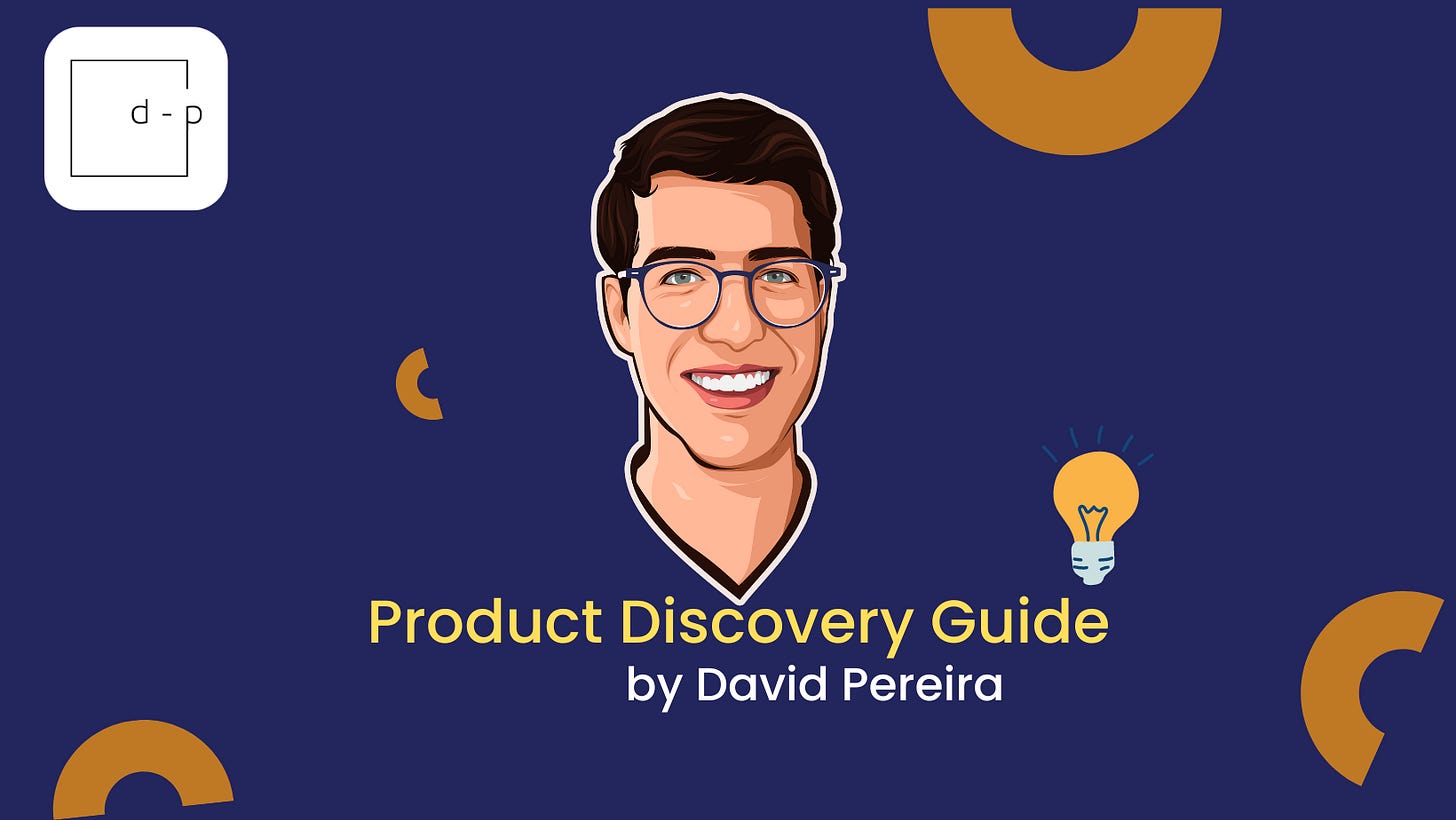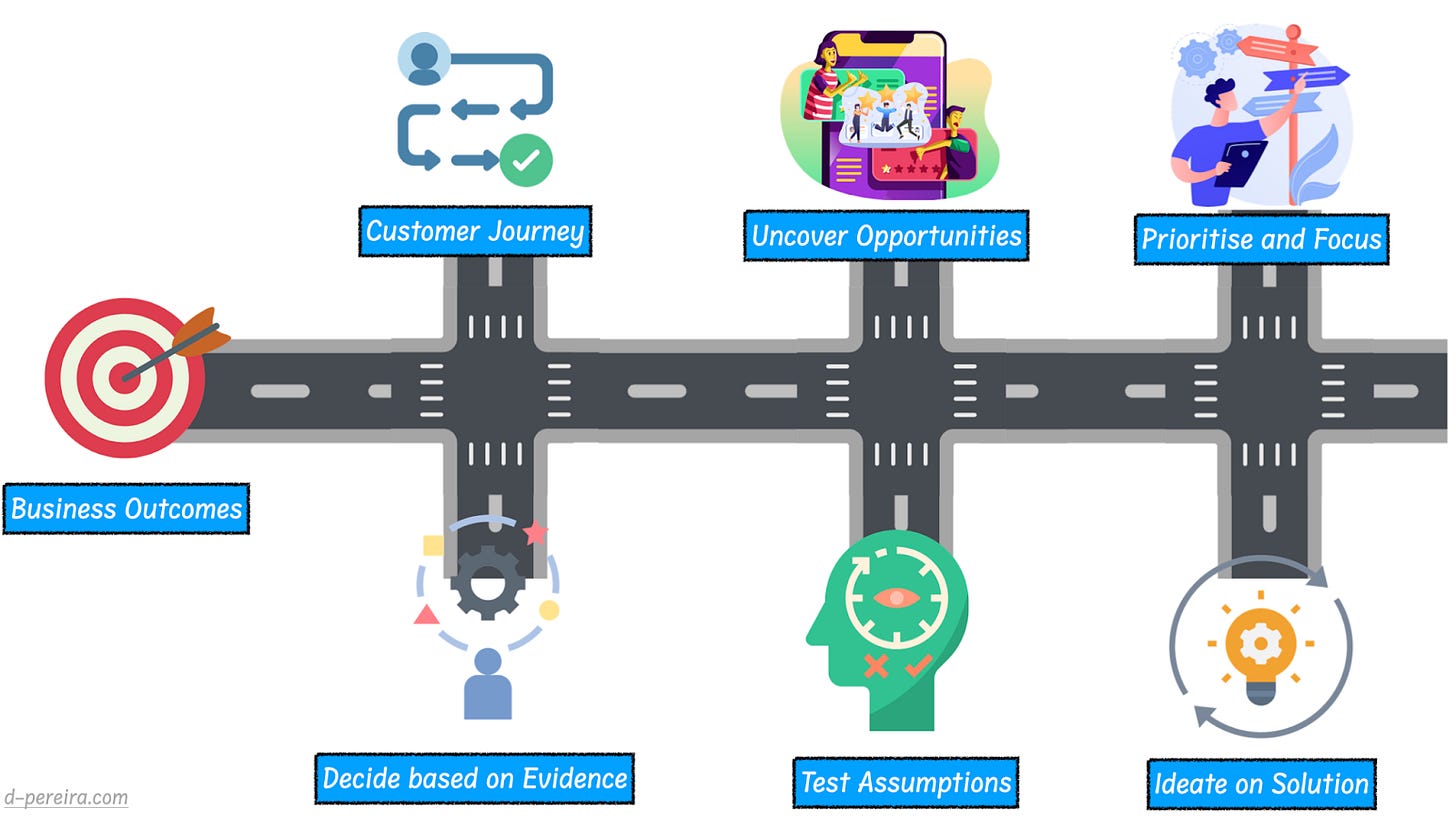A Complete Product Discovery Guide
Understanding what it takes to create value
If you want shortcuts to product discovery, stop here and read no further.
This episode of Untrapping Product Teams is a product discovery deep dive. It will take around 35 minutes of reading time to digest the content. I wrote this guide to share stories and practices to give you applicable insights on product discovery.
By the end of this read, you will know the critical elements of product discovery and how to apply them in practice.
I understand if reading a long guide isn’t your cup of tea. Alternatively, you can join my upcoming Product Discovery Cohort. Either way, I want to help you rock the product world!
Shall we start?
Sunday, 4:37 pm, my phone rings. It’s my new boss.
David. Don’t go to the office tomorrow. Come to Albert Einstein Hospital at 08:30 am. My wife is sick, and I’m staying here. Before you start, I will walk you through what you need to know.
I was sure my new job wouldn’t be like my previous one. That was my first time at a startup. Back then, I lived in São Paulo, the largest city in South America. But the meeting point was just a 10-minute walk from my place. I was lucky. At least, I thought so.
As agreed, I went to the hospital and met with the CEO of the startup I had just joined. I imagined the first meeting to last around an hour or so, but it didn’t take longer than 7 minutes. And I was speechless after it. The CEO told me:
David. Let me be direct with you. Results matter, so you better be fast. We’ve got 10 million USD cash and burn 1 Million per month. Raising capital takes from three to six months. So we better prove a market fit, or you start looking for a new job after six months. Let me tell you what you must achieve in three months—a 30% increase in conversion rate. Talk to the Tech Lead and UX Designer to figure out how to redesign our Dealers' App because they dislike it. I don’t want excuses. Get it done. We will talk in a month again.
As my coffee got cold, I reflected. I honestly didn’t know what to do. But I started structuring my thoughts and reading between the lines. The CEO gave me a goal and a solution. And I thought, what if the solution is wrong? I better learn how to test it as fast as possible. I took a cab and went to the office. On the way, I reflected on what I should do.
Once I got to the office. I was surprised; the UX Designer and Tech Lead were in another country, and neither spoke Portuguese. I wondered, “How can they create something for car dealers without understanding them?” I decided to visit car dealers to observe how they work, their challenges, and how our solution helped them.
It was 2016, and I got into something I had no idea how to solve. I was used to gathering requirements, writing user stories, estimating, and accelerating delivery. This time was different. I had a goal to pursue and a potential solution that I doubted. Without knowing, I started doing discovery work due to my excessive curiosity and unwillingness to mindlessly follow a solution. That was my first experience with product discovery, which would shape my take on product management forever.
Over the years, I evolved and shaped my product discovery knowledge with more methods and techniques. But I got my real-life lessons by stepping into cold waters and trying different things.
I will share my discovery takes and techniques from Teressa Torres, Marty Cagan, and Jeff Patton during this guide. I respect what these gurus share and their invaluable contribution to the product world. And I can only recommend you to read their books and content.
You may wonder why you should read my perspective on discovery. You will get how I apply, what works for me, and what doesn’t. This should broaden your view on this matter and enable you to pick suitable techniques for your situation.
Discovery vs. Delivery
I cannot start discussing product discovery without approaching product delivery. Both are highly intertwined, and I’d dare to say that one cannot thrive without the other.
In summary, product discovery uncovers what creates value, while product delivery produces what creates value.
I need to be blunt. I’ve seen so many aberrations over my journey that I cannot stay silent. Sometimes, companies assign product discovery and delivery to different teams. I’ve never seen that work. It creates no accountability from end to end. Inevitably, things go wrong, and it becomes a blame game. The delivery team blames discovery for poor direction, and discovery blames delivery for poor execution. No one wins. Everyone loses.
Teams need to have full accountability to thrive. That means from discovery to delivery. But then comes one challenge. How do you balance between both? Finding a sustainable balance is mandatory to succeed. Otherwise, success becomes no more than a dream.
I see three common scenarios, and only one that works.
1 - Focus on delivery
Some teams develop an obsession with maximizing delivery. That can happen due to pressure from the business or a lack of product discovery understanding. When delivery becomes the focus, success means delivering more features. The more, the better.
The result is often a cluttered product with many features that create no value.
When all energy goes to the present, somebody else creates the future.
2 - Focus on discovery
The other side of the coin is an extreme focus on product discovery. The team aims for perfection and struggles to define what’s enough. They continuously apply product discovery and test different solutions but struggle to commit to delivering something.
The result is dreadful. Nothing gets done, and everyone gets disappointed.
When all energy goes to the future, somebody else creates the present.
3 - Balance
A better way is a sustainable divide and conquer. Part of the team invests around 80% of its time into product discovery and the rest into delivery, while the other part does the opposite. This scenario has a sustainable balance between discovery and delivery. Yet, it’s hard to sustain the present and future together. That’s why some members focus on the future while others on the present.
The critical aspect is understanding that it’s one team, not micro teams. The part responsible for discovery put their effort into uncovering what matters and dropping bad ideas. The ones in charge of delivery ensure they drive business outcomes. Together, they craft meaningful solutions to solve worthwhile problems.
The result is terrific. The team takes ownership of their present and future.
I cannot ignore the elephant in the room. Many teams work with Scrum and struggle to understand how to combine discovery and delivery in the same sprint. As a reminder, Scrum is a means to an end, and the end is creating valuable products. When you balance discovery and delivery with the same team. You face a dual-track reality with the team.
A common way of solving this puzzle is by defining who will focus on the future and present. That’s when the product trio fits well. A product manager, designer, and software engineer (it can differ depending on your product) work on the problem space and uncover opportunities. The rest of the team focuses on delivering value.
Discovery Journey
My first contact with Discovery left me wondering. I thought we could repeat specific steps and consistently achieve success. But then I tried that and had to swallow a bitter taste of failure. Then, I came to a different conclusion. It’s a journey and not a plan.
I love road trips. Sometimes, my wife and I pick the car and drive through Europe. We know our final destination, but we don’t plan the stops we will have on the way. Sometimes we feel like having a coffee break, so we do it. Other times, the landscape impresses us, then we allow ourselves to take a detour and enjoy that. Eventually, we reached our final destination, but the magic was having a memorable journey full of discoveries.
When you start with product discovery, you set a business outcome. That serves as your north star. Then, you look at your customer journey and strive to uncover opportunities that could drive the desired outcome. You’ll potentially have more options than capacity, so you prioritize, identify assumptions, test the critical ones, run experiments, ideate on solutions, and invest in the most promising ones. Like a road trip, it’s about the journey; you’re the driver. You can decide whether to drive forward or backward or detour if necessary.
I’d love to give you a magic process to ensure you’ll create value at the speed of light, but I don’t allow myself to fool you. I will share the elements for a valuable discovery journey and help you understand what they help you achieve. As the driver, you will use your judgment to decide what to do, when, and for how long.
You’re the driver, not the passenger. Take ownership and enjoy the journey!
Seven elements will make the discovery journey valuable, and they are:



